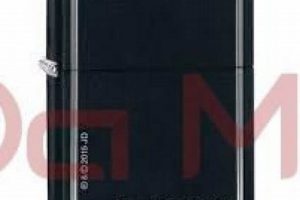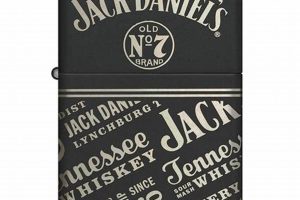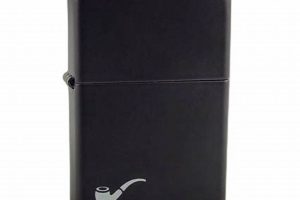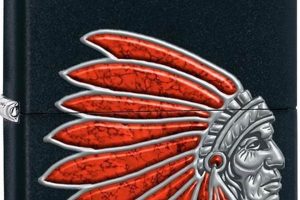Dark-colored Zippo lighters, particularly those with a painted finish, are susceptible to showing wear and tear more readily than their brushed chrome or high-polish counterparts. Minor abrasions, resulting from everyday carry and use, can expose the underlying brass or create a noticeable contrast against the dark finish. This susceptibility to visible scratching is a characteristic often observed with painted finishes on various metal objects.
The visibility of scratches on a black Zippo can be viewed differently depending on individual preferences. Some users appreciate the acquired patina and consider the accumulating marks as a testament to the lighter’s history and use, adding character. Others may prefer to maintain a pristine appearance and might explore preventative measures, such as protective cases, or restorative options like refinishing. The durability of the finish itself can also influence the extent of visible scratching; some finishes are more resilient than others. Historically, Zippo lighters have been known for their robust construction and repairability, allowing for long-term ownership even with regular use.
This inherent characteristic of darker finishes leads to discussions regarding care, maintenance, and the various available finishes offered by Zippo. Understanding the properties of different finishes allows consumers to make informed decisions based on their aesthetic preferences and anticipated usage. Further exploration into these topics can provide valuable insights for both current and prospective Zippo owners.
Tips for Maintaining a Black Zippo Lighter
Maintaining a dark-finished Zippo lighter requires attention to minimize the visibility of scratches and preserve its appearance. The following tips offer practical advice for owners.
Tip 1: Store carefully. Avoid loose storage with keys or other metal objects that could cause abrasion. Consider using a dedicated protective pouch or case.
Tip 2: Handle gently. Conscious handling can significantly reduce the occurrence of scratches. Avoid dropping the lighter or placing it on rough surfaces.
Tip 3: Choose the right fuel. Premium lighter fluid can minimize residue buildup, which can be mistaken for scratching or contribute to surface wear during cleaning.
Tip 4: Clean appropriately. Use a soft, lint-free cloth for cleaning. Avoid abrasive cleaners or materials that could scratch the finish.
Tip 5: Consider the environment. Exposure to extreme temperatures or harsh conditions can impact the finish. Store the lighter in a moderate environment.
Tip 6: Explore alternative finishes. Zippo offers a range of finishes, some more resistant to scratching than others. Research and select a finish that aligns with anticipated usage and aesthetic preferences. For example, a brushed chrome finish might be a more durable option.
Tip 7: Accept the patina. Over time, minor scratches can contribute to a unique, aged appearance. This natural wear can be seen as a characteristic of the lighter’s history.
By following these tips, owners can prolong the desired appearance of their lighter and minimize the effects of everyday wear. Regular care and mindful handling contribute significantly to maintaining the finish of a black Zippo lighter.
Understanding the nature of darker finishes and adopting appropriate care practices allows for greater enjoyment and longer-lasting aesthetic appeal. This knowledge informs choices regarding usage, storage, and overall maintenance.
1. Finish Susceptibility
Finish susceptibility plays a crucial role in determining how readily a Zippo lighter, particularly a black one, will show signs of wear, such as scratches. Darker finishes, especially those achieved through paint, tend to exhibit abrasions more prominently than polished or brushed metal finishes. This stems from the contrast between the exposed underlying metal and the dark topcoat, making even minor scratches noticeable. For example, a shallow scratch on a high-polish chrome Zippo might be nearly invisible unless viewed under direct light, while a similar scratch on a black painted Zippo will appear as a bright, readily visible line. This difference highlights the importance of understanding finish susceptibility when considering a black Zippo. The painted layer adds a distinct aesthetic, but it comes with inherent vulnerability to showing wear.
The specific type of paint used also influences scratch visibility. A high-gloss black finish, while visually appealing, tends to showcase micro-abrasions and swirl marks more readily than a matte or textured finish. The smooth surface of a high-gloss finish reflects light uniformly, making imperfections stand out. In contrast, a matte black finish diffuses light, effectively camouflaging minor scratches and wear. This difference demonstrates how even within the category of “black” finishes, susceptibility varies based on the specific paint characteristics. Consumers seeking a less scratch-prone option might consider a matte or textured finish. Furthermore, surface hardness plays a role; harder finishes are generally more resistant to scratching. The application process also impacts durability; multiple thin coats can offer better scratch resistance than a single thick coat.
Understanding finish susceptibility is therefore critical in managing expectations regarding a black Zippo’s long-term appearance. Choosing a particular finish involves weighing aesthetic preferences against practical considerations of wear and tear. While high-gloss black offers a striking aesthetic, it demands greater care to maintain its pristine appearance. A more resilient finish, like a matte black or even a different material altogether like brushed chrome, might be a more practical choice for users concerned about visibility of scratches. Recognizing these factors allows informed decisions aligned with individual needs and aesthetic preferences. Regular maintenance and mindful handling can also minimize the effects of daily wear on any chosen finish.
2. Material Properties
Material properties directly influence a Zippo lighter’s resistance to scratching, particularly for black models where blemishes are more apparent. The case material, typically brass, possesses inherent hardness and durability. However, the outer finish determines the scratch resistance. A black Zippo often features a painted finish, which is less resistant to abrasion than the underlying brass. This painted layer, while providing the desired aesthetic, is susceptible to scratches that expose the brass beneath, creating a noticeable contrast. The specific type of paint, its application process (e.g., powder coating versus wet paint), and thickness influence the final durability. For example, a thinner coating may wear down faster, exposing the underlying brass more readily than a thicker, more robust application. Furthermore, certain paint formulations offer inherent scratch resistance; some contain additives or hardening agents that increase their durability.
Beyond the external finish, the material of potential contacting objects matters. Keys, coins, and other metal items carried alongside a Zippo in a pocket can cause scratches. These materials possess varying hardness levels; steel keys, for example, present a higher risk of scratching a painted Zippo than softer metals like copper or aluminum. Even seemingly innocuous materials like sand or grit can cause micro-abrasions over time, dulling the finish and contributing to a worn appearance. The interaction between the lighter’s finish and these everyday materials exemplifies the practical significance of material properties in determining scratch susceptibility. Protective cases made from softer, non-abrasive materials like fabric or leather can mitigate the risk of scratches caused by contact with other objects.
Understanding material properties helps consumers make informed decisions and manage expectations regarding a black Zippo’s long-term appearance. Recognizing the inherent vulnerability of painted finishes compared to bare metal or alternative finishes like brushed chrome informs choices regarding handling and storage practices. Selecting appropriate storage solutions, such as dedicated cases or pouches, can minimize contact with abrasive materials and help maintain the lighter’s aesthetic. While the inherent durability of brass ensures the lighter’s functionality, the outer finish determines its aesthetic longevity. Careful consideration of these material properties allows users to balance the desired black aesthetic with practical considerations of wear and tear, enabling them to preserve the lighter’s appearance over time.
3. Handling Practices
Handling practices significantly influence the likelihood of a black Zippo lighter acquiring scratches. The painted finish, while aesthetically pleasing, is more susceptible to abrasion than raw metal. Careless handling, such as tossing the lighter into a pocket containing keys or coins, increases the risk of scratches. The hardness and shape of these items can cause varying degrees of damage, ranging from fine hairline scratches to deeper grooves. For example, keys with sharp edges pose a greater threat than rounded objects. Similarly, placing the lighter on abrasive surfaces like concrete or asphalt can lead to scratching. Even seemingly minor habits, such as repeatedly rubbing the lighter against fabric, can create micro-abrasions over time, dulling the finish. Therefore, mindful handling is crucial for maintaining the appearance of a black Zippo.
Developing specific handling habits can minimize the occurrence of scratches. Storing the lighter in a dedicated case or pouch provides a barrier against abrasive objects. Using a designated pocket, free from keys and coins, reduces the risk of incidental contact. Handling the lighter with clean hands prevents the transfer of grit and grime, which can act as abrasives. Consciously placing the lighter on soft surfaces, rather than dropping it or setting it down carelessly, mitigates potential damage. These practices, while seemingly minor, cumulatively contribute to preserving the lighter’s finish. Furthermore, understanding the impact of handling practices extends to cleaning. Using abrasive cleaning agents or rough cloths can create scratches. Opting for soft, lint-free cloths and gentle cleaning solutions minimizes the risk of damage during maintenance.
Minimizing scratches on a black Zippo requires conscious effort and attention to handling practices. Understanding the relationship between handling and potential damage empowers owners to adopt preventative measures. While the inherent susceptibility of the finish plays a role, mindful handling significantly influences the extent and visibility of scratches over time. Adopting protective measures, such as using dedicated cases and practicing gentle handling techniques, contributes to preserving the lighter’s aesthetic and extending its lifespan. Ultimately, recognizing the impact of handling practices allows for informed choices that balance practicality and aesthetic preservation.
4. Environmental Factors
Environmental factors play a significant role in the wear and tear of a black Zippo lighter, particularly regarding the visibility of scratches. While the inherent susceptibility of the finish contributes to scratching, environmental factors exacerbate the issue, accelerating the degradation of the lighter’s appearance. Understanding these factors allows owners to take preventative measures and manage expectations regarding the lighter’s aesthetic longevity.
- Pocket Debris
Everyday carry exposes a Zippo lighter to various forms of pocket debris: lint, dust, sand, and small metallic particles. These act as abrasives when the lighter rubs against other objects in the pocket, creating micro-abrasions on the painted surface. Over time, these micro-abrasions accumulate, dulling the finish and increasing the visibility of scratches. For example, fine sand particles, while seemingly innocuous, can cause significant wear over time, especially on softer finishes. The constant friction between the lighter and pocket debris accelerates the wear process.
- Temperature Fluctuations
Exposure to extreme temperatures can impact the structural integrity of the lighter’s finish. Extreme heat can cause the paint to soften, making it more susceptible to scratching. Extreme cold, conversely, can make the paint brittle, increasing the risk of chipping and cracking. These fluctuations, particularly rapid changes, weaken the finish over time, making it less resistant to everyday wear and tear. For instance, leaving a lighter in a car on a hot day can soften the paint, increasing the likelihood of scratches when it comes into contact with other objects.
- Humidity and Moisture
High humidity and direct exposure to moisture can degrade the paint finish over time. Moisture can penetrate the paint layer, causing it to lift or peel. This process weakens the overall finish, making it more vulnerable to scratching. Furthermore, moisture can promote corrosion of the underlying brass, especially if the finish has already been compromised. For example, exposure to saltwater can accelerate corrosion and damage the finish, leading to more noticeable scratches and overall wear. Protecting the lighter from excessive humidity and moisture is crucial for preserving its appearance.
- UV Exposure
Prolonged exposure to ultraviolet (UV) radiation from sunlight can cause fading and discoloration of the painted finish. While not directly causing scratches, UV exposure degrades the paint’s protective qualities, making it more susceptible to subsequent scratching and wear. This weathering effect is more pronounced with darker colors, like black, which absorb more UV radiation than lighter colors. Over time, UV exposure can significantly impact the overall aesthetic of the lighter, making existing scratches more prominent and accelerating the overall wear process.
These environmental factors, combined with the inherent vulnerability of a black Zippo’s finish, contribute significantly to its susceptibility to scratches. Recognizing these factors allows owners to adopt preventative measures, such as using protective cases and storing the lighter in controlled environments. While some degree of wear is inevitable with regular use, mitigating the impact of environmental factors helps preserve the lighter’s appearance and prolong its aesthetic lifespan. Ultimately, understanding these influences empowers owners to make informed decisions regarding care and maintenance, maximizing the longevity of their black Zippo lighter.
5. Perceived Aesthetics
Perceived aesthetics play a crucial role in how scratches on a black Zippo lighter are interpreted. While objectively, scratches represent surface damage, their perception varies significantly among owners. Some view scratches as blemishes, detracting from the lighter’s pristine appearance. This perspective often leads to preventative measures like protective cases or careful handling to minimize wear. Others, however, embrace the accumulation of scratches as a sign of character, a visual record of the lighter’s history and use. This perspective aligns with the concept of a “patina,” where acquired wear adds to an object’s aesthetic appeal. For example, a well-worn black Zippo, bearing the marks of years of use, might be considered more aesthetically appealing than a pristine, unused one. This subjective interpretation highlights the complex relationship between perceived aesthetics and physical wear.
The influence of perceived aesthetics extends beyond individual interpretation. Cultural and social contexts also shape how scratches are viewed. In some subcultures, a worn and scratched object signifies authenticity and experience. This contrasts with mainstream consumer culture, which often prioritizes pristine, flawless appearances. A scratched black Zippo, within certain circles, could be perceived as a symbol of ruggedness or rebelliousness. Conversely, in professional settings, a pristine lighter might project a more polished image. These contrasting perceptions highlight the social dimension of aesthetics, influencing how scratches are interpreted and valued. Marketing and branding also leverage these perceptions; some brands intentionally create products with a “distressed” look to evoke a sense of history or authenticity.
Understanding the influence of perceived aesthetics provides insight into consumer behavior and product design. Manufacturers recognize the diverse perspectives on wear and tear. Some offer various finishes, catering to preferences for both pristine and aged appearances. The availability of restoration services, like refinishing, further acknowledges the varying perceptions of scratches. Ultimately, the “acceptability” of scratches on a black Zippo is subjective, shaped by individual preferences, cultural contexts, and marketing influences. Recognizing this subjectivity allows manufacturers to cater to diverse aesthetic preferences, offering products and services that align with varying interpretations of wear and tear. This understanding also empowers consumers to make informed decisions based on their personal aesthetic values, recognizing that a scratch can be both a blemish and a mark of character, depending on individual perspective.
6. Preventative Measures
Preventative measures are crucial for mitigating the likelihood of scratches on a black Zippo lighter, given the inherent vulnerability of its finish. These measures aim to minimize contact with abrasive materials and reduce the impact of environmental factors, preserving the lighter’s aesthetic appeal. Implementing preventative measures demonstrates a proactive approach to ownership, recognizing the susceptibility of black Zippos to showing wear and tear. The effectiveness of these measures depends on consistent application and consideration of individual usage patterns.
- Protective Cases
Specialized cases, pouches, or sleeves offer a primary defense against scratches. These enclosures create a barrier between the lighter and potentially abrasive objects, such as keys or coins, often carried in pockets. Cases made from soft, non-abrasive materials like leather, suede, or microfiber provide optimal protection. Form-fitting cases further minimize movement within the enclosure, reducing the risk of scratches caused by friction. The choice of case material and design influences its effectiveness; a loose-fitting case made from a rough material could potentially cause micro-abrasions itself. Investing in a quality protective case demonstrates a commitment to preserving the lighter’s finish.
- Designated Storage
Designating a specific location for storing the lighter when not in use reduces the risk of incidental scratches. This could involve placing the lighter in a dedicated compartment within a bag, on a soft surface within a drawer, or on a display stand. Avoiding loose storage with other metal objects minimizes the potential for contact and subsequent scratching. For example, placing the lighter in a small, padded box prevents contact with other items that might be stored in the same drawer. This practice reinforces mindful ownership and reduces the likelihood of accidental damage.
- Careful Handling
Mindful handling practices minimize the risk of dropping the lighter or subjecting it to unnecessary contact with abrasive surfaces. Avoiding placing the lighter on rough or uneven surfaces, like concrete or asphalt, prevents scratching. Handling the lighter with clean hands prevents the transfer of grit and grime, which can act as abrasives. Consciously setting the lighter down gently, rather than tossing it onto a surface, reduces the risk of impact damage. These handling practices, while seemingly simple, cumulatively contribute to maintaining the lighter’s pristine appearance.
- Regular Cleaning
Regular cleaning with appropriate materials removes potentially abrasive debris that can accumulate on the lighter’s surface. Using a soft, lint-free cloth prevents micro-abrasions that can occur with rougher materials. Avoiding abrasive cleaning agents or harsh chemicals further protects the finish. Gentle wiping motions remove dust and fingerprints without causing further wear. This regular maintenance, while not directly preventing scratches, mitigates the risk of abrasive particles causing damage over time. Furthermore, it allows for regular inspection of the lighter’s surface, enabling early detection of any potential issues.
These preventative measures, when implemented consistently, significantly reduce the likelihood of a black Zippo lighter acquiring scratches. While the inherent vulnerability of the finish remains, proactive measures minimize the impact of environmental factors and handling practices. By adopting these strategies, owners demonstrate a commitment to preserving the lighter’s aesthetic appeal and extending its lifespan. The effectiveness of these measures ultimately depends on individual diligence and awareness of potential scratch-inducing situations. Combining these preventative measures with an understanding of the factors contributing to scratching, such as material properties and perceived aesthetics, allows owners to make informed decisions and maintain their black Zippos in a condition that aligns with their personal preferences.
7. Restoration Options
Restoration options provide avenues for addressing scratches and other wear on black Zippo lighters, counteracting the inherent susceptibility of their finish to damage. These options range from simple cleaning and polishing techniques to more involved professional refinishing processes. The availability of restoration options allows owners to maintain a desired aesthetic, even after the lighter has accumulated scratches through regular use or unforeseen incidents. Understanding these options empowers informed decision-making regarding long-term care and preservation.
- DIY Cleaning and Polishing
Minor surface scratches and scuffs often respond well to gentle cleaning and polishing techniques. Using a soft, lint-free cloth and a non-abrasive metal polish can minimize the appearance of superficial scratches. This approach requires careful execution to avoid further damage; excessive pressure or abrasive materials can exacerbate existing scratches or create new ones. DIY cleaning and polishing offer a readily accessible and cost-effective solution for addressing minor wear, but their effectiveness is limited to superficial blemishes. Deeper scratches or significant damage require more extensive restoration methods.
- Professional Refinishing
Professional refinishing services offer a more comprehensive solution for restoring a black Zippo lighter to its original condition. These services typically involve stripping the existing finish, addressing any dents or deeper damage, and reapplying a new finish. Professional refinishing can effectively eliminate scratches, restoring the lighter’s pristine appearance. However, this process can be more expensive than DIY methods and requires relinquishing the lighter for a period of time. The quality of the refinishing depends on the service provider’s expertise and the materials used. Choosing a reputable service provider ensures a high-quality, durable finish that matches the original aesthetic.
- At-Home Refinishing Kits
At-home refinishing kits offer a compromise between DIY cleaning and professional services. These kits typically include the necessary materials and instructions for removing the existing finish and applying a new one. While less expensive than professional refinishing, at-home kits require careful execution and attention to detail to achieve satisfactory results. The quality of the final finish depends on the user’s skill and the quality of the kit’s components. At-home refinishing provides a more involved approach than simple cleaning and polishing, allowing for the restoration of more significant damage, but it carries a higher risk of error compared to professional services.
- Embracing the Patina
An alternative approach involves accepting the accumulated scratches and wear as part of the lighter’s character. This perspective views the marks as a testament to the lighter’s history and usage, adding a unique patina that distinguishes it from unused lighters. Embracing the patina obviates the need for restoration efforts, recognizing the inherent evolution of an object’s appearance over time. This perspective aligns with the concept of wabi-sabi, finding beauty in imperfection and impermanence. While some scratches might detract from a pristine aesthetic, others might appreciate the acquired character and history reflected in the lighter’s worn appearance.
The choice of restoration option depends on individual preferences, the extent of the damage, and budgetary considerations. Recognizing the availability of these options empowers black Zippo owners to maintain their lighters in a condition that aligns with their aesthetic values. While preventative measures can minimize the occurrence of scratches, restoration options provide avenues for addressing inevitable wear and tear, ensuring the lighter’s continued aesthetic appeal and functionality over time. The inherent susceptibility of black Zippos to scratching necessitates consideration of these restoration options as part of long-term ownership.
Frequently Asked Questions
This section addresses common inquiries regarding the susceptibility of black Zippo lighters to scratches, offering concise and informative responses.
Question 1: Are black Zippo lighters more prone to scratching than other finishes?
Darker finishes, particularly those achieved with paint, tend to show scratches more readily than polished or brushed metal finishes due to the contrast between the exposed underlying metal and the dark topcoat.
Question 2: What materials cause the most scratches on a black Zippo?
Harder materials like keys, coins, and other metal objects commonly carried in pockets pose a significant scratch risk. Even seemingly benign materials like sand or grit can cause micro-abrasions over time.
Question 3: Can scratches on a black Zippo be removed?
Minor scratches can sometimes be minimized with gentle polishing using a non-abrasive metal polish and a soft cloth. Deeper scratches may require professional refinishing services or the use of at-home refinishing kits.
Question 4: How can one prevent scratches on a black Zippo?
Preventative measures include storing the lighter in a protective case or pouch, designating a specific pocket free of abrasive objects, handling the lighter with clean hands, and avoiding placing it on rough surfaces.
Question 5: Do all black Zippo finishes scratch equally?
No, the specific type of paint and its application influence scratch resistance. High-gloss finishes tend to show micro-abrasions more readily than matte or textured finishes.
Question 6: Does Zippo offer any scratch-resistant finishes in black?
While no finish is entirely scratch-proof, some finishes offer greater resistance. Exploring alternative finishes offered by Zippo, including different textures and coatings, may provide options with increased durability.
Understanding the factors contributing to scratches on black Zippo lighters, along with preventative and restorative options, enables informed decisions regarding care and maintenance. Regular maintenance and mindful handling practices can significantly extend the aesthetic lifespan of a black Zippo lighter.
This information serves as a foundation for making informed decisions regarding the purchase, care, and maintenance of a black Zippo lighter.
Conclusion
The inquiry “do black Zippo get scratch” underscores the inherent vulnerability of darker finishes to exhibiting wear and tear. Exploration of material properties, handling practices, environmental factors, and perceived aesthetics reveals a complex interplay influencing the visibility and interpretation of scratches on black Zippo lighters. While the painted finish increases susceptibility to abrasions, preventative measures, ranging from protective cases to mindful handling, can significantly mitigate the accumulation of scratches. Restoration options further provide avenues for addressing existing damage, offering choices aligned with individual preferences and budgets.
Ultimately, understanding the factors influencing scratch visibility empowers informed decisions regarding the acquisition, care, and long-term appreciation of black Zippo lighters. Recognizing the interplay between material characteristics, usage patterns, and individual perceptions allows for a balanced approach, weighing aesthetic preferences against practical considerations of wear and tear. This awareness ensures sustained enjoyment of these iconic lighters, regardless of the inevitable accumulation of marks that tell the story of their use and ownership.







